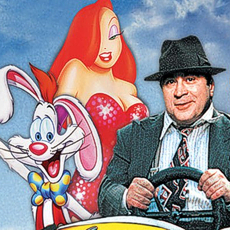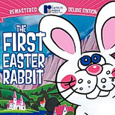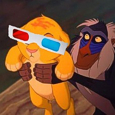Touchstone Pictures/Amblin Entertainment (June 22 1988), Buena Vista Home Entertainment (March 25 2003), 2 disc set, 104 mins plus supplements, 1.85:1 anamorphic widescreen, Dolby Digital 5.1 and DTS Surround, Rated PG, Retail: $19.99
Storyboard:
1947 Hollywood: Who Framed Roger Rabbit follows famed animated “toon” star Roger as he gets deeper and deeper into trouble after cartoon gag-king Marvin Acme (head of the factory that supplies every one of Wile E Coyote’s Road Runner contraptions) is found murdered. The bunny goes on the run, turning to down-on-his-luck gumshoe Eddie Valiant, known for his celebrated assisting of toons in trouble. Eddie’s non-too pleased to see Roger since he became a toon-hating human after his brother was killed by a falling piano in a bank-job in down town ToonTown, the secret over-the-hill location set aside by Los Angeles for the cartoon characters of Hollywood to live without irritating their live-action counterparts. Turning up on the scene is Judge Doom, a mysteriously shady lawman with more connections that may first seem apparent, and a plan to reduce ToonTown to rubble so that he can carry out his dastardly freeway plans… Roger and Eddie must overcome their differences, outwit some nifty double crosses and join up to battle Doom and his sneaky team of Weasel cohorts and save ToonTown from the bulldozers!

The Sweatbox Review:
For those signalling the death knoll for Disney’s 2-disc special edition DVDs, I would point you towards this new issue for their groundbreaking film Who Framed Roger Rabbit, a set bursting with an abundant amount of the good value and quality features we’ve come to expect from the Studio.
First appearing as a graphic novel comic-style book by Gary K Wolf, Roger Rabbit places the animated cartoon stars of yesteryear in the real-life world that we inhabit. Bought to the Disney Studio by then studio head Ron Miller, the film was put into development in the early 1980s, when the cost of producing the film to the standards thought to be needed proved too high. Eventual director Robert Zemeckis was actually offered the chance of helming the film in 1983, but the feeling in Hollywood at the time was that the once all-powerful Disney Studios were no longer in a position to mount such a huge production. Terry Gilliam also passed on the project, as he thought it would be “too difficult”! The Studio takeover of 1984 put the film on hold for another couple of years until it resurfaced under the guidance of new Mouse chiefs Michael Eisner and Jeffrey Katzenberg, with none other than Steven Spielberg expressing an interest in coming on board as producer. Their choice to direct such a large-scale film was Zemeckis, who had just made a hit film for Spielberg’s Amblin Entertainment, Back To The Future. Three years later, they had another hit, when Roger opened to spectacular box-office returns in the summer of 1988.
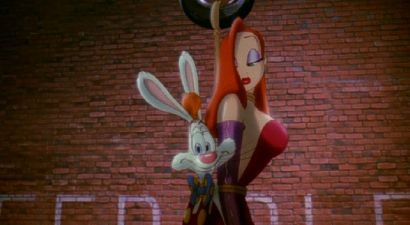
Brilliantly directed by Robert Zemeckis and complimented perfectly by Richard Williams’ animation, Roger leaps from the screen to amaze and astound – some of these sequences, even 15 years later, never fail to impress the viewer, with a dazzling display of groundbreaking visuals and technical effects. This is one of those films when everything and everyone came together at the right time, to produce a pitch perfect movie that has become a true classic. Originally considered for the role of Valiant was Gene Hackman, known for his hard-boiled detective roles, but eventual choice Bob Hoskins plays it better than anyone else ever could. His Eddie Valiant is dead-on, creating just the right tone of isolation and annoyance at Roger’s behavior, while never coming across as someone who does not have that little tiny part of them that remembers what being a kid and loving cartoons was like.

A triumph of animation and special effects, Roger himself integrates with the real world like no other cartoon character before or since. Thanks to the involvement of Industrial Light And Magic, artists were able to add light and shadows to the toons, creating the real feeling of dimensionality. In promoting the film in 1988, Richard Williams joked that “it wasn’t three dimensionality, but 2-and-a-half at least!” However, the effect works so well for pretty much all of the movie that the illusion is soon forgotten and the film draws you in to the whodunit story itself. In fact the plot of Who Framed Roger Rabbit is far trickier than first appears, or other critics would have you believe, and is quite an accomplished thriller in itself – a Chinatown, if you will, with a bunch of crazy toons thrown in to spin it on its head! The effects never outweigh the story, and its this attention to getting the plot right that really helps Roger to play as a “serious” movie for adults, while retaining the family angle. And at the end of the day, Roger lives up to its promise of being a tribute to all those toons we loved as kids, by being a film made by adults simply having fun and doing what makes them laugh!

There are a couple of inconsistencies in Roger Rabbit, although as a rabid fan I am duly forced to defend them, of course! One of the most widely remarked mistakes was made with The Singing Sword (itself a reference to the Bugs Bunny cartoon Knighty Knight Bugs), which sings in a Frank Sinatra voice. Nothing wrong with that I hear you say, but anyone wanting to criticise can point out that the song sung, Witchcraft, would not be a Sinatra hit for a few years after the film’s 1947 setting. I would have to reply that I reckon songwriters Cy Coleman and Carolyn Leigh themselves acquired a Singing Sword ten years later, liked the song, and re-wrote it for Frank, who made it a hit in 1960 – simple! Another qualm was with Angelo’s comment in the Terminal Bar, when Judge Doom asks if any of them had seen a rabbit. Angelo jokes that he has indeed, and puts his arm around his invisible friend “Harvey”, a reference to a film that did not appear until 1950. However, did you know that by this time Harvey was already an amazingly successful Pulitzer Prize winning Broadway play? The show first appeared in 1944, with James Stewart himself (later to play in the film version, which coincidentally shares Roger’s 104-minute running time) playing appearing for a limited time in 1947. So, little to complain about there!

Of course with a film this big in scope and technical ambitiousness, there are bound to be many “mistakes” and minor irregularities. But then again, for a film this big and with the amount of technical effects to keep an eye on, there are remarkably very few actual gaffs, unlike for instance the high-tech films of today which regularly beat each other for the film with most blunders in. Who Framed Roger Rabbit was also made a time (just) before computer technology allowed for perfect matte shots, digital wire removal, CG-enhanced clean-up effects and the like, which makes its achievements all the more worthwhile and remarkable. It’s certainly an all-round entertaining film, and one that is able to back itself up with strong storytelling and technical talent; a hit movie that did lots to put animation back on the map in moviegoers eyes, and played no small part in launching the Disney renaissance of the 1990s. Highly recommended!
Is This Thing Loaded?
As Who Framed Roger Rabbit is one of my all time favorite films (the combination of Disney/Zemeckis/Spielberg must place it fairly high on any list), I know of a wealth of material that could and should have been included here. The disc itself is cut into two “separate versions”: the “Family” edition (full-screen feature) on disc one, and disc two’s “Enthusiast” edition (with the feature in widescreen), although there is sufficient material on both discs that most people will want to pop both into their players (but not at the same time, I would recommend)!

As a major fan, I was expecting the Joanna Cassidy (Delores) hosted 50-minute special Roger Rabbit And The Secrets Of ToonTown, a fantastic old-school behind-the-scenes documentary that aired on TV during Roger’s original 1988 theatrical release. This program also included several snippets of additional deleted scenes that are no where to be found on this new disc, and it would have been nice to have either had the Secrets program or a deleted scenes montage. The extra material is spread across the two discs, although I felt that some of it should have been carried over from the second to the first, as compression on disc two’s features is fairly noticeable. This also means that the Secrets documentary could have easily been placed on disc one, in addition to the new retrospective documentary as seen here on disc two. A missed opportunity, but let’s see what we DO have…
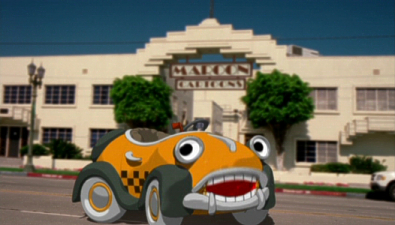
Both discs open up with a wild version of the film’s logo dancing around to the Maroon Cartoon Studio’s opening music. It’s a crazy way to start, but made me laugh and set the tone for what was to follow. On Disc One, we’re introduced to Benny The Cab, in a main menu with some newly animated footage (don’t get too excited – Benny is realized on screen using 2D-shaded CGI and the shot only lasts a matter of seconds). On Disc One he leads us on a fast-paced chase downtown, with the disc’s options shown on a pop-up map. In the Acme Warehouse you’ll find the Who Made Roger Rabbit featurette, which features material from the electronic press kit from the original 1988 release. Hosted by Charles Fleischer (voice of Roger and Benny), this otherwise new 11-minute piece takes us behind the scenes in a kid-friendly way, explaining the ins and outs of production. It’s a surprisingly entertaining program, with some clever video trickery placing Fleischer in Roger’s world, as well as archive photos and clips. Fans of the movie should check this out, even if it is meant for kids!
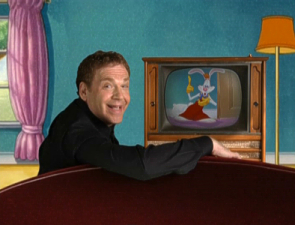
More fun for kids is found in the set-top game Trouble In ToonTown where the player must help Roger save the Toons from a new dip-dripping device! I’m no fan of these kinds of games, and very rarely get around to actually playing them, but this one has enough whiz-bang graphics and new voice work by Charlie Fleischer as Roger to keep it interesting. By turns easy and hard to play, at least my saving grace was that I managed to answer each question correctly! It’s not just a Q and A game though – the player must throw pies, mallet the weasels and skip the dip! Also in the Acme factory (strangely rendered on this “full-frame” family disc in 16×9 anamorphic widescreen) are a number of jokes and hidden comic animations well worth checking out, and all produced in the spirit of the film.
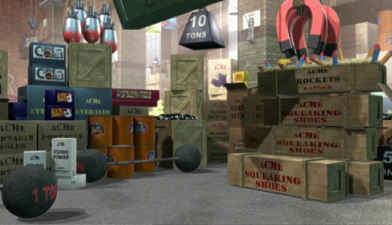
Back to Benny’s map-menu, and in The Ink And Paint Club you’ll find sneak peeks at two kids DVD titles, Schoolhouse Rock and Ultimate X, while Valiant’s Office takes you to the set-up options for the film (including a handy THX Optimizer). In the Movie Theater, there’s the main feature itself of course, as well as the Scene Selection choices. Search around on Benny’s map, and you also may be lucky enough to find the original theatrical trailer, presented in pretty grainy full-frame, but an important and welcome addition nonetheless! Best of all on this disc is the inclusion of the three full-length Maroon Cartoons (accessible from the Acme menu) that were produced as “mini-sequels” after the huge success of the feature in theaters (and to keep Roger in the public’s mind for the as yet un-made official follow-up).
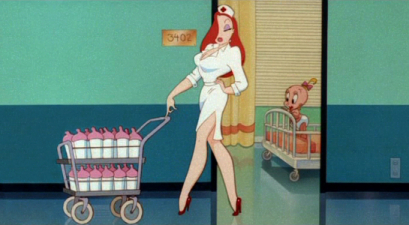
In Tummy Trouble, released just one year later in 1989, Roger has to look after Baby Herman again when Mother goes out. There’s a brief reference to the Something’s Cookin’ cartoon in Who Framed… when Mother tells Roger that this time all must go well, “not like the LAST TIME”!! Inevitably, Roger screws up, when Herman swallows a baby rattle, so it’s off to St Nowhere’s hospital to help out poor Baby. Soon Roger is up to his bow-tied neck in emergency room trouble, causing chaos in the wards. It’s a really funny cartoon, and the only one from the three made that actually plays through as a complete cartoon from beginning to end without resorting to rather choppy endings. A nice throwback to the original film comes at the finale, when the camera pulls back to reveal the live-action set and Jessica (also seen in the short as one of the most attractive nurses in film-history – “hello nurse!” indeed) waiting to take Roger home. Tummy Trouble played with Honey, I Shrunk The Kids in theaters, and was seen as a major part of that film’s success (witness the under performing sequel and the direct-to-video third film, which was ironically the directorial debut of Who Framed… director of photography Dean Cundey). The cartoon was not included in the initial video release of Honey, but was added again to the film’s retail release (in full-frame only).
Here all the added shorts are presented in handsome anamorphic widescreen, at roughly their OAR of 1.66:1. Roller Coaster Rabbit, the next on the list and released with Dick Tracy in 1990 (and once again with Toy Story in 1995) disappoints slightly with a strangely non-eventful ending, but does contain some quite frankly hysterical gags. On an outing to a fairground with Mother and Baby Herman, Roger is once again left holding the Baby while Mother goes to get her palm read (nice Clarabelle Cow joke here). Again, Herman escapes from Roger’s not-so watchful eyes and is soon leading the bunny on chase through dangerous attractions, which of course leave Baby Herman unscathed and Roger a shivering mess! The two end up in a roller coaster cart (fantastic visual gag here of just how high this ride goes), which spins and twists through an almighty maze of tracks and outrageously fast-paced gags (look for a message in one point-of-view shot of the coaster’s tracks). The short comes to an abrupt end when the cart takes a wrong turn and smashes off the set and into the real world, where the director insists on Roger doing “the whole take again”!
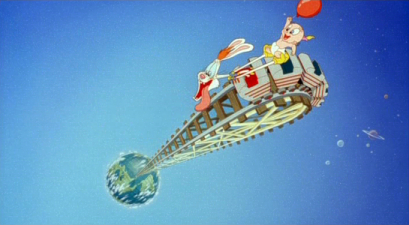
On release with 1993’s A Far Off Place, Trail Mix-Up was virtually invisible in the film’s advertising and remains the least seen Roger/Maroon Cartoon. It’s also one of the best (though again suffers from an ending that cuts the action short). We find Roger, Baby and Mother in a wildlife park, where Roger is inevitably given the task of watching over Herman while Mother goes off hunting. Distracted by sexy forest ranger Jessica, Roger loses Herman and the chase is once again on. Both Tummy Trouble and Roller Coaster Rabbit were directed by animator Rob Minkoff (later of The Lion King, the first two Stuart Littles and the recent Haunted Mansion), while this last effort falls to Barry Cook to helm, doing a sterling job in carrying on with the Tex Avery-paced style. On release, one joke flew by too quickly for audiences to notice, but viewers of the now hard to find CAV LaserDisc edition of the home video compilation The Best Of Roger Rabbit did chance upon a background gag only seen in freeze-frame mode. When Roger swoops down to rescue Baby Herman from certain doom in the sawmill, he passes by a poster advertising Rigid Tools, featuring the definite shape of a woman straddling a chainsaw. The image was the reason the LaserDisc was pulled, with subsequent issues on VHS (in pan and scan only) having the poster airbrushed out, making the image a blob of messy shapes rather than a noticeable picture. In this edition, the poster is not as clear as on that original CAV LD, but has not been airbrushed out as heavily as the VHS copies – you certainly will still get the joke if you look carefully enough! Again the short ends when things on set go wrong, but this one has a good pay-off and it’s worth watching the credits for an amusing, post-title finish.
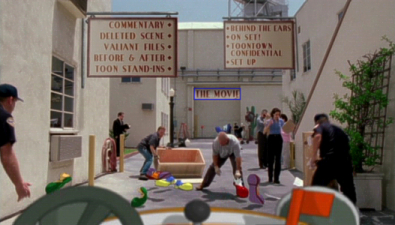
Disc Two’s “Enthusiast” collection of extras, as mentioned above, really delves into the making of the movie. Benny’s back, this time leading us to the Maroon Cartoon Studios, faithfully reconstructed for this DVD release with new footage, including some fun Toon cameos. Extras begin with a full-length commentary track featuring director Robert Zemeckis, producer Frank Marshall, writers Jeffrey Price and Peter Seaman, co-producer Steve Starkey and visual effects whiz Ken Ralston. Each describe in some detail how challenging the film was to make, and the amazing logistics they had to overcome to bring it to the screen. It’s the same track as was recorded for the 1998 video release that was held back from the film’s first DVD edition, but was available on the Special Edition LaserDisc (which also contained the three Maroon Cartoons), so those who have that disc may want to pass this time around. It’s a fun commentary, the crew recall the most tiny moments in the film’s production, explain Steven Spielberg’s contribution, and point out a few gaffs along the way too! One gaff of their own that I have to clarify: at one time someone mentions that the film was shot in England at “a studio that no longer exists, called Elstree Studios”. I can let the boys know that the Studio is indeed still there – I work there, with a Roger portrait looking over the way to my office. George Lucas also recently shot scenes for the Star Wars prequels at Elstree, and we also recently re-welcomed Touchstone with The Hitch-Hiker’s Guide To The Galaxy!
In the still gallery Valiant Files there’s a bunch of stuff to wade through – all kept in secret locations in Eddie’s office. If you don’t fancy trying your investigative skills, click on the file paper for a list of “files” to pick out: there’s everything from Character Development, Concept Art (including alternate titles – Die Wundersamen Abenteuer Von Herbert Hase Im Trickfilm Land has to be a favorite – and some early Chuck Jones contributions), Stills, and Publicity, with some really great alternate poster artwork and a look at the DisneyLand recreation of ToonTown.
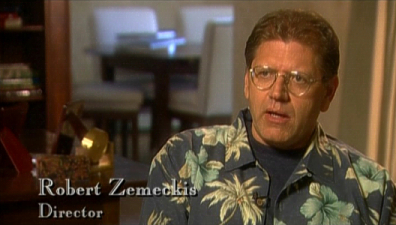
The majority of the additional featurettes are only slightly disappointing, but do open up the world that the filmmakers inhabited for almost three years. Before And After highlights the entire Eddie-in-ToonTown sequence in split-screen form, with the completed film playing against what was shot on set. Blue screens, prop rigs and storyboards all play a part in the creation of a classic scene, although this is less a featurette and more simply an intriguing look at the production process. Likewise Toon Stand-Ins, which is more on-set footage, although this time with some brief comments from the filmmakers. This clip shows shots from the Terminal Bar room brawl, with the rubber stand-in characters in place for rehearsals, which were later removed and re-shot for the animation to be added in. On Set With Benny The Cab features further production footage, this time shown “as it happens”, with Zemeckis and the crew setting up and filming the shot. There are no quick cuts, and the material is allowed to speak for itself, and although these three clips (all shown in full-frame) are not “making of featurettes” that zip by quickly, they do offer a very interesting insight into the process of making the film from a basic and therefore plain-to-see point of view.
ToonTown Confidential is a fun subtitled trivia track that plays as pop ups during the actual movie. Featuring an absolutely unstoppable amount of facts, figures and fun, the track is worth a once through, and I found that playing it with the commentary saved time and the two work well to compliment each other. All in all, a wealth of interesting trivia, including the revealing of in-jokes and a couple of surprises!

The centerpiece in the bonus material on this disc is the new documentary Behind The Ears: The True Story Of Roger Rabbit. Though early reports promised a program lasting an hour or so, it actually comes in at just over 35 minutes. Using footage shot at the time of production, as well as clips from the movie, the documentary is mainly a series of “talking head” interviews with the principle filmmakers as they are today. Here they all get a chance to explain just how “seat of their pants” the making of Who Framed Roger Rabbit really was. No one had made a movie like this before and it seems that they made up the rules as they went along! Much of the material has been covered before (in the original Secrets Of ToonTown program and the commentary on the disc), but it is nice to get a perspective view on the production from those closest to Roger. Best of all is the chance to see Richard Williams’ 30-second test that convinced all the major parties (mainly Disney and Spielberg) that Roger Rabbit could “live” in the real world with great believability, and crazy Charles Fleischer on set in his rabbit costume.
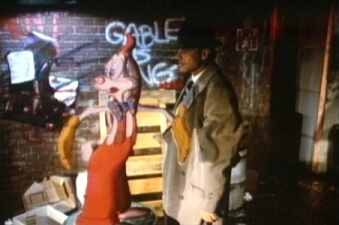
By far my most favorite bonus was the inclusion of the almost legendary deleted Pig Head Scene. The first shots to be animated, this sequence was later dropped as the quality of the animation was quickly upped during production and Zemeckis felt that this scene, coming in the middle of the picture, would suddenly jump out at the viewer as not being high enough in standard to the rest of the animation (although here it is explained that they thought it slowed the story down). The scene is totally completed, with finished sound and color, and was in fact inserted back into the film for certain TV showings of Roger. The sequence (coming just before Jessica visits Eddie in his office) explains why Eddie is coming out of the shower when she arrives, and although it’s great to have the scene on disc, it would have been even better to include a branching option that ran the scene within the movie, as was intended.

There is much more that could have been included in this 2-disc set, not least by dropping the redundant full-screen feature on disc one for more in-depth extras. It would also have been great to complete the interrupted Maroon Cartoon Something’s Cookin’ – the opening Roger short – for this home video release. Surely after Roger was cleared of murder, Raoul J Raoul finished off this mini-masterpiece before entering politics? However it is hard to complain at such a well thought out and entertaining set – everything such as it is turns up present and correct, and apart from the missing material mentioned above, fans of the Rabbit will be very happy that Roger has finally gotten the treatment he deserves.
When it comes to DVD-ROM material however, it looks like Judge Doom has dipped this disc – there is no added content.
Case Study:
Coming in a slipcased foldout digipak, Who Framed Roger Rabbit’s debut as a deluxe edition DVD could not have wished for more appropriate packaging. The slipcase itself is foil embossed, lending it a classy shimmer of its own, while inside you’ll find a replica of one of Eddie’s personal “files”, opening up to present the two discs (designed as film reels, naturally) and a Valiant And Valiant notebook.
The notebook acts as a Guide to the DVD, with scene selections and bonus feature overviews including informative descriptions of the Pig Head Scene, Behind The Ears and more. There are also two reproductions (though sadly not printed on harder card) of publicity photos of Roger and Jessica, “personally autographed” by the two Maroon Cartoon Studios stars! Lastly, a $5 rebate for those who bought the previous Roger DVD is a nice touch.
Ink And Paint:
Pleasing everyone in one release, Roger is offered in both pan-and-scan 1.33:1 full-screen and 1.85:1 theatrical anamorphic widescreen. I felt there was some danger of heavy compression on the widescreen edition, as the full-screen (on disc one) only has a couple of sound options, a half-hour of added content and a game, whereas disc two’s original ratio version has a lengthy documentary, commentary, featurettes, Dolby and DTS audio options – quite a fair bit to squeeze on! Happily, although more space could have been given to the movie and some extras pushed to disc one, the film does not suffer in the compression stakes (although see below for the state of the added material). I centered my viewing around the original widescreen ratio presentation, of course, which looks pretty clean. Due to the way the film was matted together in an optical printer, it will never have the illumination and clarity of a film from today, even given the obvious digital makeover this print has been given. But it’s a good-looking transfer, colors are strong and compression manages to stay low.

Just for the record, the full-frame version has the film in a hybrid open matte/pan-and-scan framing: Roger was shot open matte, but only the live-action only parts retain this ratio as the animation shots (well over two thirds of the film) were hard matted to 1.85:1. Thus, the best and most consistent viewing option on the disc is – surprise! – the original theatrical widescreen ratio version found on disc two. When it comes to the added material, things don’t fare so well, and there is a noticeable amount of macro blocking and mosquito noise to be found in the darker areas of the image, mainly on the Behind The Ears documentary. Thank goodness this only applies here and not to the majority of other featurettes or to the main feature, which looks clean and fine.
Scratch Tracks:
Always a film with an exceptionally aggressive sound mix, Roger has been given an added DTS-added track for disc two’s widescreen presentation in this DVD issue. The Dolby 5.1 track also sounds top-notch however, and to be honest I did not notice any real differences between the Dolby and DTS tracks from this new disc and the original CAV LaserDisc pressing. Spaciousness seems to have been opened up, and as usual the DTS offers more punch in the lower frequencies, but those with 5.1 Dolby can happily turn up their woofers to pretty much attain the same effect. The dialog, much of it added later in ADR (automated dialog replacement), is locked center stage, with the zany sound effects spilling from all corners. Speaking of an earlier Spielberg/Zemeckis collaboration, 1941, New York film critic Pauline Kael commented that the movie was like having your head stuck in a pin-ball machine for two hours. Zemeckis later used this quote to describe Roger, and listening to the sound mix on display here, you’ll get exactly what he means! Well-dubbed French and Spanish tracks are also available on both versions of the film, with English subtitles also an option.
Final Cut:
As you’ll probably have noticed, Who Framed Roger Rabbit is one of my favorite films and this disc finally gives the film a new chance to shine. The packaging is really nice, with that silver sheen to the outer slipcase and the nice wallet-styled “case file” holding the discs, which are illustrated as film reels – an inspired touch which gives all the influences of the film a reference. An added treat are those “signed photos” of Roger and Jessica, and “Eddie’s guide” to the discs themselves, which add to the overall feeling that a lot of affection has gone into producing this title.
Long overdue, but well worth the wait, this Who Framed Roger Rabbit Vista Series DVD is a great treatment for a groundbreaking movie, and will hopefully help Roger find many new fans. The legacy of the film is hard to calculate – Roger arguably sparked the animation renaissance and its techniques led to the amazing visuals of recent animation from all studios. No-one has done the combination of animation and live-action as well since, and even with the latest computer technology at their hands, the makers of the recent Looney Tunes movies still had the giant task of beating a true hand-crafted original. Although rivalry between Disney and Katzenberg’s studio DreamWorks means that a Roger sequel would be a hard act to pull together, here’s hoping that this set is the first step in forging those elements in place so that Roger can work his magic again on the big screen. If not, then at least fans can rest assured that this one-of-a-kind entertainment will never be forgotten, with this disc an essential purchase and a fine representation of this amazing and downright magical movie!
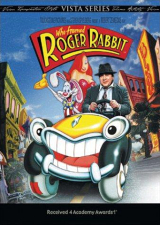 | ||
 |






